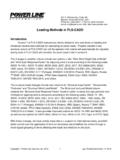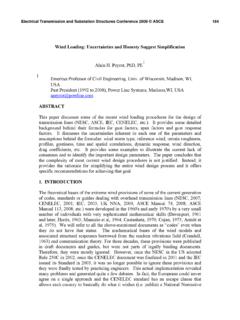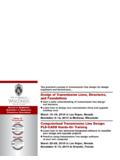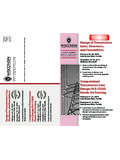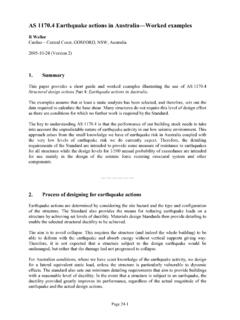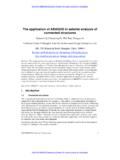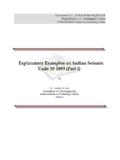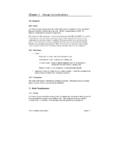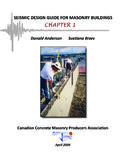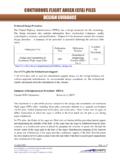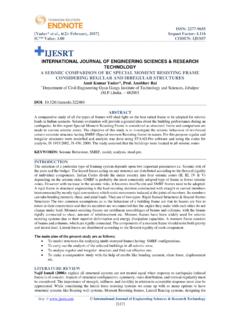Transcription of Using ANSI/TIA 222-G in TOWER and PLS-POLE
1 Copyright Power Line Systems, Inc. 2010 Last Revised February 19, 2010 1 610 N. Whitney Way, Suite 160 Madison, Wisconsin 53705, USA Phone No: (608) 238-2171 Fax No: (608) 238-9241 Email: URL: Using ANSI/TIA 222-G in TOWER and PLS-POLE Introduction TOWER and PLS-POLE have been tracking the evolution of ANSI/TIA 222-G for some years. 222-G represents an enormous change from 222-F in both the loading and strength philosophies employed. This document will briefly explain how TOWER and PLS-POLE can be used to meet some of the requirements of 222-G . Revisions July 2007: Addendum 1 incorporated into TOWER and PLS-POLE version with the following changes: Renamed design check to " ANSI/TIA 222-G -1" to make it clear that Addendum 1 is included.
2 : Updated exposure category extent from 10 to 20 times structure height : Warnings that refer to this section now print the Grf should be to : TOWER : Ka = min( ,(1- )) now only applied when subcritical (so Ka = for supercritical wind case may change to Ka = 1) : TOWER : Ka is applied by the program so should not also be applied in through as per Note 3 in : The allowable horizontal displacement is now 3% of structure height instead of 5% in the Service Loads Check Table 2-2: TOWER does not automate the special case of "latticed structures with other than triangular or rectangular cross sections TOWER never suffered from this typo Resistance factor for compression changed from to (Eqns.)
3 EIA-G-7 and EIA-G-8 in the TOWER manual) Resistance factor for compression changed from to One quarter of the bolt diameter is now added to dist1 and dist2 used for calculating RDIS (Eqns. EIA-G-17 and EIA-G-18 in the TOWER manual) The factor has been changed to for RDIS, but RBSH still uses (Eqns. EIA-G-14 and EIA-G-15 in the TOWER manual) Copyright Power Line Systems, Inc. 2010 Last Revised February 19, 2010 2 February 2008, TOWER version : Now exactly implement this section rather than Using simpler, but more conservative ASCE 10-97 method for block shear Now calculate Anet = (Aeff - h x t x nh) rather than the more conservative Anet = ( x Aeff) - (h x t x nh) which was introduced in July 2007 with Addendum 1 Notes for Users of 222-F Models made in previous versions that used 222-F will open in the current version and produce the same results they did before.
4 In addition, you will continue to be able to select 222-F as a strength check and a loading option. In fact, the 222-F support in TOWER and PLS-POLE has improved in version 7 as described in the Notes on Version 7 for Telecommunications Users section below (which was taken from the Loading Methods Introduced in Version 7 of TOWER and PLS-POLE technical note). Getting Started With 222-G The geometry of a TOWER or PLS-POLE model will not require any changes to be used with 222-G (except for bolts in TOWER see below). You can switch to the 222-G strength check simply by selecting it in General/General Data. Loads unfortunately are a completely different matter.
5 Wind speeds in 222-F were fastest mile and in 222-G they are now based on a 3s gust. Therefore, a 222-F .eia file cannot be automatically converted to a 222-G .eia loads file by TOWER or PLS-POLE . Instead, you must create a new EIA loads file Using Loads/EIA Loads. The type of file (F or G) created is based on the load type selection you made in General/General Data so you will want to switch to 222-G prior to doing this. Once you are in the Loads/EIA Loads table you will find that you need to input some additional information including: Structure Class, Topographic Category (and possibly Topographic Factor, Kzt and Crest Height, H), Exposure Category, design spectral response at short periods and at one second (SDS and SD1).
6 Please refer to 222-G for a definition of these variables. In addition, for each load case you will need to select a type: Regular, Service or Earthquake. Service loadcases are used to calculate serviceability limit state deformations and selecting Service for Load Case Type will result in the following: the importance factor is set to 1, the directionality factor, Kd, to (as per section ) and an uncracked modulus of elasticity is used for concrete poles. No change is made to the topographic factor Kzt. The Earthquake Load Case Type implements the provisions of section as shown in Table 1 below. All load cases that are neither Service nor Earthquake should be input as Regular.
7 The final piece of input that is required is the Mean Wind Start and Stop Elevations. Wind loads applied to a structure between these elevations will have the mean wind conversion factor m applied to them. This allows you to investigate the pattern wind requirements of section for guyed masts. Copyright Power Line Systems, Inc. 2010 Last Revised February 19, 2010 3 Table 1: Seismic Analysis Methods Implemented in PLS-POLE and TOWER Structure Type Analysis Procedure Height Limit - No mass or stiffness irregularities Height Limit - With mass or stiffness irregularities Tubular pole Method 2 No Limit 200ft [61m] Self Supporting Lattice Method 2 No Limit 600ft [183m] Guyed Mast Method 1 No Limit 1500ft [457m] Detailed Notes Prior to making use of 222-G in PLS-POLE or TOWER you should read that code in detail along with these notes.
8 The following notes correspond to section numbers in 222-G and will help you to understand the implementation of 222-G in PLS-POLE and TOWER . , : TOWER : Temperature effects are considered for guyed and self supporting structures. You enter the Guy Installation temperature in General/EIA Options (note that this temperature should be 60 F). PLS-POLE : Temperature effects are considered for steel poles and guys. The guy installation temperature is hard coded to 60 F. Guys will always have a dead load factor of 1 (Dg = 1) regardless of what is input in Loads/EIA Loads for the dead load factor. Concentrated loads input in the Point Loads subtable of Loads/EIA Loads are already assumed to be factored (the load factors in Loads/EIA Loads are not applied to them).
9 You should input the load combinations from , any additional load combinations needed for wind pattern loading as per and any additional load cases that are necessary in the Loads/EIA Loads table. : If you input an ice thickness in Loads/EIA Loads then the ice will be applied to your structure even if it is less than (6mm) thick. : Kz is calculated automatically for you. : If any of these situations apply to your structure location you should adjust the input wind speed accordingly. : You must input the topographic category in Loads/EIA Loads. : TOWER : You input the building elevation in General/EIA Options. PLS-POLE : If your pole is placed on top of another structure, the Z coordinate entered in Steel/Wood/Concrete Poles Geometry must correspond to the elevation at the base of the pole .
10 : If you select a topographic category of one in Loads/EIA Loads then Kzt will always equal one. For category two through four, Kzt will be calculated as per this section and you must input a Crest Height, H, greater than zero. Kzt will be calculated at the appropriate height for all components (mid-height of sections, attachment height for equipment) except guys where a single uniform value of Kzt calculated at the mid-height of the structure Copyright Power Line Systems, Inc. 2010 Last Revised February 19, 2010 4will be used. For category five you must input a single Kzt which will be used for the entire structure. : Gh is calculated automatically for you.

